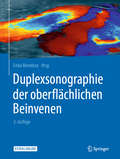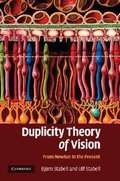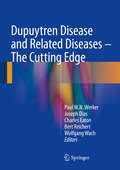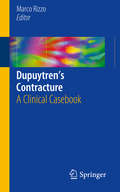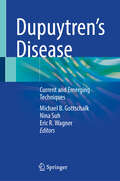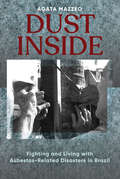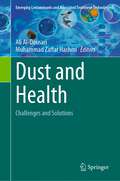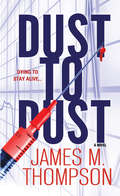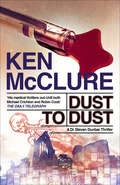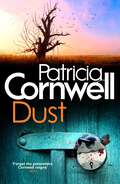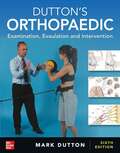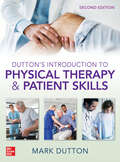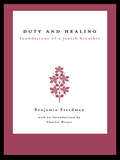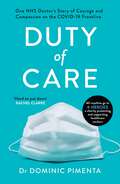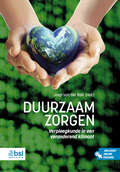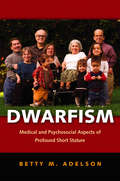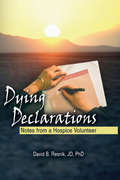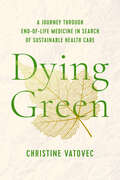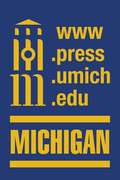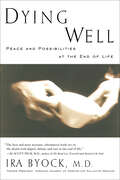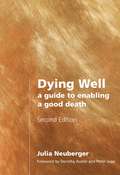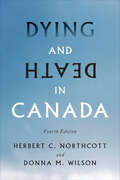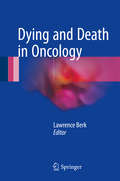- Table View
- List View
Duplexsonographie der oberflächlichen Beinvenen
by Erika MendozaAllen Ärzten, die Venen operativ oder konservativ behandeln, bietet dieses Buch eine praxisorientierte Anleitung zur Sonographie der oberflächlichen Venen. Die einzelnen Venensegmente werden mit Normalbefund, häufigen und seltenen pathologischen Bildern und differenzialdiagnostisch wichtigen Nebenbefunden ausführlich dargestellt. In der Neuauflage sind die aktuelle anatomische Nomenklatur und die Stadieneinteilung berücksichtigt, zudem werden neue therapeutische Verfahren besprochen. Die beigefügte DVD enthält zusätzliches Bild- und Videomaterial.
Duplicity Theory of Vision: From Newton to the Present
by Bjørn Stabell Ulf StabellThe duplicity theory of vision concerns the comparisons (both differences and similarities) and interaction between the cone and rod systems in the visual pathways, with the assumption that the cone system is active during daylight vision and the rod system functions in low light (night time). Research on this aspect of vision dates back to the 17th century and the work of Newton, and is still ongoing today. This book describes the origin and development of this fundamental theory within vision research - whilst also examining the Young-Helmholtz trichromatic colour theory, and the opponent colour theory of Hering - and presents evidence and ideas in light of modern conceptions of the theory. Written for academic researchers and graduate students, the book brings back knowledge of the tradition of duplicity theory, inspiring questions related to anatomy, comparative biology, molecular biology, photochemistry, physiology, genetics, phylogenetics and psychophysics.
Dupuytren Disease and Related Diseases - The Cutting Edge
by Charles Eaton Wolfgang Wach Paul M. N. Werker Joseph Dias Bert ReichertIn this book, leading international experts showcase the latest advances in research into Dupuytren disease and its clinical management. The coverage spans all relevant specialties, including cell biology, biomechanics, genomics, surgery, pharmacotherapy, and radiotherapy. The opening sections address epidemiology, cellular and extracellular events, and genetics. Treatment by means of collagenase injection, percutaneous needle fasciotomy, and other surgical and minimally invasive approaches is then extensively discussed. Comparative studies of different approaches are reviewed, and aspects of patient assessment, examined. The prevention and treatment of disease recurrences are also addressed. Further sections consider related conditions, other treatment options, and future pathways for research. This book should be read by all who treat or conduct research into Dupuytren disease. It is based on presentations delivered at the 2015 International Conference on Dupuytren Disease, held in Groningen, the Netherlands, which was designed to promote a coordinated global response to the disease involving patients, scientists, and clinicians.
Dupuytren's Contracture
by Marco RizzoComprised exclusively of clinical cases involving Dupuytren's contracture, this concise, practical casebook will provide clinicians in orthopedics and hand surgery with the best real-world strategies to properly diagnose and treat this recurrent disease of the fascia. Each chapter is a case that opens with a unique clinical presentation, followed by a description of the diagnosis, assessment and management techniques used to treat it, as well as the case outcome and clinical pearls and pitfalls. Initial chapters discuss non-operative treatments ranging from orthosis/tissue mobilization, corticosteroid injections, needle aponeurotomy and collagenase injections. Various surgical interventions follow, including fasciotomy, fasciectomy, open palm, and dermatofasciectomy. Chapters discussing the use of skin grafting, illustrating the special challenges associated with revision surgery, and "end of the line" interventions such as arthrodesis and amputation are also included. Less common aspects of Dupuytren's are reviewed as well, as are cases that address treatment and special consideration in younger patients, the role/use of dynamic external fixators in Dupuytren's care, correction of distal interphalangeal (DIP) joint contractures and treatment of dorsal finger (Garrod's) nodes. Pragmatic and reader-friendly, Dupuytren's Contracture: A Clinical Casebook will be an excellent resource for orthopedic and hand surgeons alike.
Dupuytren's Disease: Current and Emerging Techniques
by Eric R. Wagner Michael B. Gottschalk Nina SuhDupuytren&’s contractures are a very common pathology with a complex underlying pathophysiology that is associated with controversy regarding the proper treatment algorithm. Although many patients do not develop contractures, when the contractures do develop and hand function is compromised, there remain multiple important considerations when deciding on the initial or ultimate treatment for these patients. Although dermatofasciectomy with skin grafting and open fasciectomy have historically been the gold standard, less invasive procedures, including percutaneous needle aponeurotomy (NA) and clostridial collagenase injections, have been gaining popularity in recent years. This book provides a comprehensive yet concise discussion of Dupuytren's disease, ranging from historical perspectives and background to current evidence-based medicine outcomes for treatment. It reviews the considerations for each of these treatments, as well as other innovative strategies, such as the digit widget. The goal is to focus on surgical/procedural techniques and tips to optimize outcomes, while educating readers on how to make an evidence-based decision taking into account patient outcomes and cost considerations. With a world-renowned panel of authors on this disease process, the focus is on optimizing the reader's skillset for each treatment strategy. In addition, it is also important to understand some of the granularity as it relates to historical perspectives and what previous treatments may or may not have worked (e.g., McCash technique). This book also provides perspectives of the historical background up until today as well as groundbreaking work in regard to the genetic implications it may or may not have.
Dupuytren’s Disease and Related Hyperproliferative Disorders
by M. Heinrich Seegenschmiedt Ardeshir Bayat Charles Eaton Giulio Gabbiani Paul Werker Wolfgang WachThis book is based on results of the 2010 International Symposium on Dupuytren's disease held in Miami, Florida, but it also includes new data and additional chapters. It is hoped that it will raise awareness of this underestimated condition and promote cooperative efforts to work towards a cure. Up to date information is provided on the epidemiology, biology, and pathology of the disease. The principles and specifics of treatment are explored in detail. The indications for and techniques of radiotherapy, minimally invasive treatments and open surgery are fully explained. The role of physical therapy is considered as well as the care of relapse and complications. The treatment of Ledderhose's disease and Peyronie's disease is also discussed. This book provides invaluable information for hand surgeons, podiatrists, orthopedists, radiation therapy specialists and general practitioners. It will help to foster an interdisciplinary approach to the understanding and management of this debilitating disorder.
Durchflusszytometrie in der Hämatologie: Lehrbuch für die Vorbereitung auf die Facharztprüfung
by Julie Schanz Nils BrökersDie Durchflusszytometrie ist ein obligater Baustein in der Diagnostik hämatologischer Erkrankungen und daher Teil der Weiterbildung zum Facharzt und Fachärztin in der Hämatologie und Onkologie, sowie Labormedizin. Die Methode sowie die korrekte Interpretation der Ergebnisse muss von allen Weiterzubildenden erlernt werden und ist Teil der Facharztprüfung. Aus dem Inhalt: Einführung in die Methodik, die korrekte Indikationsstellung und die Interpretation von Ergebnissen in der hämatologischen Durchflusszytometrie; Sortierung der Zellen, Fluoreszenzmessung, Präanalytik, Analytik; Diagnostik von Lymphomen, akuten Leukämien und nicht-malignen hämatologischen Erkrankungen; Qualitätsmanagement und leitliniengerechte Befunderstellung u.v.m.Verständlich geschrieben und flüssig zu lesen sowie mit zahlreichen Abbildungen illustriert ist es das perfekte Lehrbuch für Assistentinnen und Assistenten in der Weiterbildung sowie MTAs, die in Speziallaboren für die Hämatologie tätig werden wollen.Plus: Fragen zur Wissensüberprüfung über die SN FlashCards App und Fallbeispiele aller in der Hämatologie relevanten Diagnosen sowie Zugang zum exklusiven Online-Kurs.
Dust Inside: Fighting and Living with Asbestos-Related Disasters in Brazil
by Agata MazzeoToxic production, disrupted lives and contaminated bodies. Care for unacknowledged suffering, incurable cancers, and immeasurable losses. This book bears witness to the invisible disasters provoked by the asbestos market worldwide and gives a voice to the communities of survivors who struggle daily in the name of social and environmental justice. Grounded in a profound, touching ethnography, this book offers an original contribution to understanding global health disasters and grassroots health-based activism.
Dust and Health: Challenges and Solutions (Emerging Contaminants and Associated Treatment Technologies)
by Muhammad Zaffar Hashmi Ali Al-DousariThis book discusses the sources, human health hazards and risk prevention strategies associated with aeolian dust particles (fine and ultrafine) in the atmosphere. It covers the challenges of accurately forecasting aeolian dust and the need to raise public awareness on the warning signs and harmful impacts of airborne dust. Also discussed is the presence of microorganisms, heavy metals and other pollutants in dust which contributes to harmful impacts on human health as well as management and treatment options for the various health issues that can result from exposure. The book is a useful resource for scientists, engineers and policymakers interested in dust and health.
Dust to Dust
by James M. ThompsonA MEDICAL MIRACLE The first subjects are lab rats. Injected with two experimental drugs by two different doctors, the rats begin to show signs of renewed youth, restored health, and remarkable vigor. Surprised by the results, neurologist Kat Williams and biochemist Burton Harris believe they have stumbled upon a major breakthrough in the science of aging. But there is only one way to know if their formula can truly reverse the aging process. Their next subject needs to be human . . . A LIVING NIGHTMARE His name is Jerome. A homeless, destitute alcoholic with no family, no history, and no hope to live, he is the ideal test subject for the next phase of the experiment. Like the lab rats, Jerome responds quickly and dramatically to the serum. But when Dr. Williams and Dr. Harris seek more funding for their study—from a paralyzed billionaire hoping to cure death itself—they make another chilling discovery about their “fountain of youth” drug. Everybody wants it. And some will kill for it . . .
Dust to Dust: A Dr. Steven Dunbar Thriller (book 8) (The Dr Steven Dunbar Thrillers #8)
by Ken McClureA search for the bodies of Black Death victims may unleash a new modern-day plague in this thriller by the international bestselling author . . . John Motram, a cell biologist at Newcastle University, firmly believes that Black Death was not caused by bubonic plague but by an unknown virus. So he&’s excited when Oxford University informs him that there might be preserved bodies of Black Death victims hidden under Dryburgh Abbey. Motram launches an excavation, but it comes to a disastrous end when he appears to suffer a mental breakdown after entering the secret tomb. Now Dr. Steven Dunbar, ex-Special Forces medic, must step in to investigate, as fears grow that a new killer virus has been let loose . . . &“His medical thrillers out-chill both Michael Crichton and Robin Cook.&” —Daily Telegraph
Dust: Number 21 In Series (Kay Scarpetta #21)
by Patricia CornwellThe twenty-first book in the Kay Scarpetta series, from No. 1 bestselling author Patricia Cornwell.'America's most chilling writer of crime fiction' The Times After working on one of the worst mass killings in US history, Chief Medical Examiner Kay Scarpetta returns home to recover, but an unsettling call drives her straight back to work. The body of a young woman has been discovered inside the sheltered gates of MIT, draped in an unusual cloth and posed in a way that is too deliberate to be the killer's first strike. A preliminary examination reveals that the body is covered in a fine dust that under ultra-violet light fluoresces blood-red, emerald-green and sapphire-blue, and physical evidence links this to another series of disturbing homicides in Washington, DC. As she pieces together the fragments of evidence, Scarpetta discovers that the cases connect, yet also seem to conflict, drawing herself and her team deeper into the dark world of designer drugs, drone technology, organised crime, and shocking corruption at the highest level. The next book in the Scarpetta series is Flesh and Blood. And the brand-new instalment, Identity Unknown, is available now!DISCOVER THE SERIES THAT SHAPED THE WORLD OF CRIME FICTION'One of the best crime writers writing today' Guardian 'Devilishly clever' Sunday Times 'The top gun in this field' Daily Telegraph 'Forget the pretenders. Cornwell reigns' Mirror 'The Agatha Christie of the DNA age' ExpressTRACE was a No.1 Sunday Times bestseller in paperback in April 2005
Dutton's Orthopaedic: Examination, Evaluation And Intervention, Sixth Edition
by Mark DuttonThe #1 most trusted evidence-based text in orthopaedic physical therapy The definitive text for orthopedic students, Dutton’s Orthopaedic: Examination, Evaluation and Intervention delivers a logical, systematic approach to hands-on orthopedic treatment. This new edition offers the perfect balance in its coverage of the continuum of care, emphasizing the appropriate use of manual techniques and therapeutic exercise while outlining the correct applications of multiple adjuncts to the rehabilitative process. Aided by decision-making algorithms, this comprehensive guide covers anatomy, biomechanics, examination, and treatment of each joint and region and features. Evidence-based and written by a prominent practicing therapist, this is an essential resource for physical therapy students and practitioners.
Dutton’s Introduction to Physical Therapy and Patient Skills,
by Mark DuttonA comprehensive intro to the art, science, and practice of physical therapy <P><P> With Dutton's Introduction to Physical Therapy and Patient Skills, Second Edition, you get complete and well-rounded coverage of the practice of physical therapy (PT). This comprehensive introduction provides the conceptual framework you need to build a solid foundation in PT—including a historical perspective of the profession, an introduction to healthcare policy, and in-depth coverage of evidence-informed practice. <P><P> The book describes how movement evolves, how it becomes skilled, and how dysfunction can occur; illustrates the necessary skills you need to successfully practice PT; explains how to development areas of expertise, including how to enhance a patient's function in such tasks as bed mobility, transfers, and gait training; and much more. The author emphasizes both patient and clinician safety through the use of correct body mechanics, application of assistive and safety devices, and infection control procedures.
Duty and Healing: Foundations of a Jewish Bioethic (Reflective Bioethics)
by Benjamin Freedman"Duty and Healing" positions ethical issues commonly encountered in clinical situations within Jewish law. The concept of duty is significant in exploring bioethical issues, and this book presents an authentic and non-parochial Jewish approach to bioethics, while it includes critiques of both current secular and Jewish literatures. Among the issues the book explores are the role of family in medical decision-making, the question of informed consent as a personal religious duty, and the responsibilities of caretakers. The exploration of contemporary ethical problems in healthcare through the lens of traditional sources in Jewish law is an indispensable guide of moral knowledge.
Duty of Care: 'This is the book everyone should read about COVID-19' Kate Mosse
by Dominic Pimenta'Beautifully written, passionate and moving, this is the book everyone should read about COVID-19' Kate Mosse'Hard to put down' Rachel Clarke'Gripping, humane, eye-opening and seriously tense' Ian DuntThe first book to tell the full story of the COVID-19 pandemic from a doctor on the frontline.ALL ROYALTIES FROM SALES GO TO HEROES, A CHARITY PROTECTING AND SUPPORTING HEALTHCARE WORKERS. On the 8th of February, Dr Dominic Pimenta encountered his first suspected case of coronavirus. Within a week, he began wearing a mask on the tube, and within a month, he moved over to the Intensive Care Unit to help fight the virus.From the initial whispers coming out of China and the collective hesitation to class this as a pandemic to full lockdown and the continued battle to treat whoever came through the doors, Dr Pimenta tells the heroic stories of how the entire system shifted to tackle this outbreak and how, ultimately, the staff managed to save lives.This incredible account captures the shock and surprise, the panic and power of an unprecedented time, and how, at this moment of despair, human generosity and kindness prevailed.'A startlingly personal account ... It can be described as a memoir, a thriller or a horror story, but it is really all at once' Observer'Reads like a thriller – a first-hand account of a group of individuals facing a terrible adversary – but it also moved me sometimes to tears because it communicates the humanity of the patients, as well as the NHS staff. As with all great writing, its honesty shines out' Tim Walker'An excellent book ... Moving and fascinating in equal measure' Xand van Tulleken
Duurzaam zorgen: Verpleegkunde in een veranderend klimaat
by Jaap van der StelDe zorgsector is aanzienlijk vervuilend vanwege grondstoffenverbruik, CO2-uitstoot en met medicijnresten die het oppervlaktewater vervuilen. Klimaatverandering en milieuvervuiling vergroten gezondheidsproblemen. Verpleegkundigen, als grootste beroepsgroep, hebben een cruciale rol in het verduurzamen van de zorg en kunnen helpen bij het verminderen van de milieu- en klimaatimpact, en het ondersteunen van patiënten hierbij. Het boek Duurzaam zorgen: Verpleegkunde in een veranderend klimaat belicht de onmisbare rol van verpleegkundigen. Het boek richt zich vooral op verpleegkundestudenten. Het laat zien hoe de zorg bijdraagt aan de duurzame doelen van de VN. Ook benadrukt het de noodzaak om mee te bewegen met het veranderende klimaat in brede zin. Sociale inclusie, milieubescherming en gezondheidszorg komen samen. Dit alles met oog voor het welzijn van mens en planeet. Duurzaam zorgen gebruikt praktijkvoorbeelden. Het verkent hoe verpleegkundigen duurzaamheid integreren in de zorg. Ze nemen het voortouw in de overstap naar groene energie. Ze maken de zorg sterker tegen extreem weer. En ze brengen duurzame innovaties in, zoals herbruikbare materialen en energiebesparing. Het boek dient als gids voor de zorgprofessionals van morgen. Het toont de kansen voor verpleegkundigen om leiders te worden in duurzame gezondheidszorg. Duurzaam Zorgen zet aan tot actie en geeft hoop op een groenere toekomst. Het nodigt uit tot het maken van positieve veranderingen in de zorg en verder.
Dwarfism: Medical and Psychosocial Aspects of Profound Short Stature
by Betty M. AdelsonThis landmark volume is the first to trace the exciting developments in the field of dwarfism research and treatment over the past century—particularly during the past fifty years. Dr. Betty M. Adelson, a psychologist, has unearthed and synthesized the most significant information about dwarfing conditions, from articles written a century ago to current books and specialized databases. Highlighting the outstanding contributions of Dr. Victor McKusick and several of his colleagues, Dr. Adelson reveals how dwarfism specialists have helped redefine the nature of medical care—transforming it from an authoritarian enterprise into a holistic, collaborative venture among physicians, affected individuals, and their families. The parent of an adult dwarf daughter, Adelson examines the social forces that affect the dwarfism community. She offers personal descriptions of the day-to-day challenges dwarf individuals face and portrays their accomplishments. Insightful and accessible, this work will prove a valuable resource for affected individuals, their families, and medical professionals—physicians, nurses, genetic counselors, social workers, psychologists, and medical students.
Dying Declarations: Notes from a Hospice Volunteer
by David B Resnik"Death strips away all of the superficial and mundane details of living and leaves behind life&’s bare essentials."Death is inevitable in life. It knows no boundaries. It knows no skin color, no financial or social standing. It knows nothing but itself. The paradox of Dying Declarations: Notes from a Hospice Volunteer is in its warm affirmation of life through the &’dying declarations&’ of patients who are peering into the cold face of death. The author reveals personal experiences about life, death, and the courage to strip away the unimportant aspects of life to make way for a clearer understanding on just what is truly important. Simple, moving stories invigorate and spark insights-while discussing all aspects of hospice volunteering."By facing death on a regular basis, one can no longer maintain a tight grip on the masks, games, and trivialities that one uses to hide from truth. The person who looks death in the eye becomes more honest, grateful, compassionate, and humble." In Dying Declarations: Notes from a Hospice Volunteer, the author shares his experiences and the lessons he learned from the dying while working as a hospice volunteer. The stories, rather than being sad and depressing, present the author&’s hospice experience as being some of the most personally uplifting and enriching experiences of his life. In Dying Declarations: Notes from a Hospice Volunteer you will learn: about training for hospice work why hospice volunteers are at times more beneficial to the well-being of dying patients than family, clergy, or medical personnel the three basic tasks for a hospice volunteer how children and dogs can be beneficial for patients the impact that a dying patient can have on the life of a hospice volunteer words of wisdom about living life, directly from hospice patientsDying Declarations: Notes from a Hospice Volunteer will inspire and enlighten hospice volunteers, nurses, physicians, clergy, social workers or anyone who works for hospice or provides end-of-life care.
Dying Green: A Journey through End-of-Life Medicine in Search of Sustainable Health Care (Critical Issues in Health and Medicine)
by Christine VatovecThe slow violence being inflicted on our environment—through everything from carbon emissions to plastic pollution—also represents an impending public health catastrophe. Yet standard health care practices are more concerned with short-term outcomes than long-term sustainability. Every resource used to deliver medical care, from IV tubes to antibiotics to electricity, has a significant environmental impact. This raises an urgent ethical dilemma: in striving to improve the health outcomes of individual patients, are we damaging human health on a global scale? In Dying Green, award-winning educator Christine Vatovec offers an engaging study that asks us to consider the broader environmental sustainability of health care. Through a comparative analysis of the care provided to terminally ill patients in a conventional cancer ward, a palliative care unit, and an acute-care hospice facility, she shows how decisions made at a patient’s bedside govern the environmental footprint of the healthcare industry. Likewise, Dying Green offers insights on the many opportunities that exist for reducing the ecological impacts of medical practices in general, while also enhancing care for the dying in particular. By envisioning a more sustainable approach to care, this book offers a way forward that is better for both patients and the planet.
Dying Inside: The HIV/AIDS Ward at Limestone Prison
by Benjamin Fleury-Steiner Carla Crowder"The HIV+ men incarcerated in Limestone Prison's Dorm 16 were put there to be forgotten. Not only do Benjamin Fleury-Steiner and Carla Crowder bring these men to life, Fleury-Steiner and Crowder also insist on placing these men in the middle of critical conversations about health policy, mass incarceration, and race. Dense with firsthand accounts,Dying Insideis a nimble, far-ranging and unblinking look at the cruelty inherent in our current penal policies. " ---Lisa Kung, Director, Southern Center for Human Rights "The looming prison health crisis, documented here at its extreme, is a shocking stain on American values and a clear opportunity to rethink our carceral approach to security. " ---Jonathan Simon, University of California, Berkeley "Dying Insideis a riveting account of a health crisis in a hidden prison facility. " ---Michael Musheno, San Francisco State University, and coauthor ofDeployed "This fresh and original study should prick all of our consciences about the horrific consequences of the massive carceral state the United States has built over the last three decades. " ---Marie Gottschalk, University of Pennsylvania, and author ofThe Prison and the Gallows "An important, bold, and humanitarian book. " ---Alison Liebling, University of Cambridge "Fleury-Steiner makes a compelling case that inmate health care in America's prisons and jails has reached the point of catastrophe. " ---Sharon Dolovich, University of California, Los Angeles "Fleury-Steiner's persuasive argument not only exposes the sins of commission and omission on prison cellblocks, but also does an excellent job of showing how these problems are the natural result of our nation's shortsighted and punitive criminal justice policy. " ---Allen Hornblum, Temple University, and author ofSentenced to Science Dying Inside brings the reader face-to-face with the nightmarish conditions inside Limestone Prison's Dorm 16---the segregated HIV ward. Here, patients chained to beds share their space with insects and vermin in the filthy, drafty rooms, and contagious diseases spread like wildfire through a population with untreated---or poorly managed at best---HIV. While Dorm 16 is a particularly horrific human rights tragedy, it is also a symptom of a disease afflicting the entire U. S. prison system. In recent decades, prison populations have exploded as Americans made mass incarceration the solution to crime, drugs, and other social problems even as privatization of prison services, especially health care, resulted in an overcrowded, underfunded system in which the most marginalized members of our society slowly wither from what the author calls "lethal abandonment. " This eye-opening account of one prison's failed health-care standards is a wake-up call, asking us to examine how we treat our forgotten citizens and compelling us to rethink the American prison system in this increasingly punitive age.
Dying Well
by Ira ByockFrom Ira Byock, prominent palliative care physician and expert in end of life decisions, a lesson in Dying Well. Nobody should have to die in pain. Nobody should have to die alone. This is Ira Byock's dream, and he is dedicating his life to making it come true. Dying Well brings us to the homes and bedsides of families with whom Dr. Byock has worked, telling stories of love and reconciliation in the face of tragedy, pain, medical drama, and conflict. Through the true stories of patients, he shows us that a lot of important emotional work can be accomplished in the final months, weeks, and even days of life. It is a companion for families, showing them how to deal with doctors, how to talk to loved ones-and how to make the end of life as meaningful and enriching as the beginning. Ira Byock is also the author of The Best Care Possible: A Physician's Quest to Transform Care Through the End of Life. .
Dying Well: A Guide to Enabling a Good Death
by Rabbi Julia NeubergerThis book explores the Care Trust concept promoted by central government for improving partnership working between health and social care. Using case studies and examples to raise current issues related to partnership working it explains how Care Trusts are bridging the gap between health and social care and considers how they are delivering more co-ordinated services and improved outcomes. All healthcare and social care professionals with responsibility for involved in or affected by the new partnership working arrangements will find this book useful reading.
Dying and Death in Canada, Fourth Edition
by Donna Wilson Herbert NorthcottDying and Death in Canada provides a comprehensive, up-to-date examination of dying, death, and bereavement from a Canadian perspective. The fourth edition covers current issues and recent developments in the field, such as the implementation of Medical Assistance in Dying (MAID) and the implications of the COVID-19 pandemic. New topics include death doulas, death tourism, psychogenic death, bonds between the living and the dead, mass death events, and cultural diversity, sensitivity, and competence. This edition combines current research and language used to destigmatize conversations surrounding suicide, while new case studies offer personal accounts from doctors, nurses, and family members of the deceased. Exploring the significance of end-of-life experiences, Dying and Death in Canada shows that how we live influences how we die, and the society and culture in which we live has a profound effect on how we behave when confronted with dying and death.
Dying and Death in Oncology
by Lawrence BerkThis book brings together in one volume many important topics about death and dying, including the pathophysiology of death, the causes of death among cancer patients, the ethics of death, the legal aspects of death for the physician and for the patient and caregivers, the economics of death, the medical management of the dying patient, including pain and dyspnea, the prediction of death, and the spiritual management of the dying patient. It also discusses other medical and humanistic aspects of death and dying, such as the historical definition of death and various cultures' and religions' viewpoints on death and the afterlife. Everybody, including every patient with cancer, will die, and every physician will have to assist dying patients. Oncologists face this prospect more often than many physicians. And yet to date there has been no comprehensive textbook on Thanatology, the academic discipline studying death and dying, to assist oncologists in this difficult task. This book will help the physician to understand his or her own relationship with death and to communicate about death and dying with the patient and the patient's caregivers.
